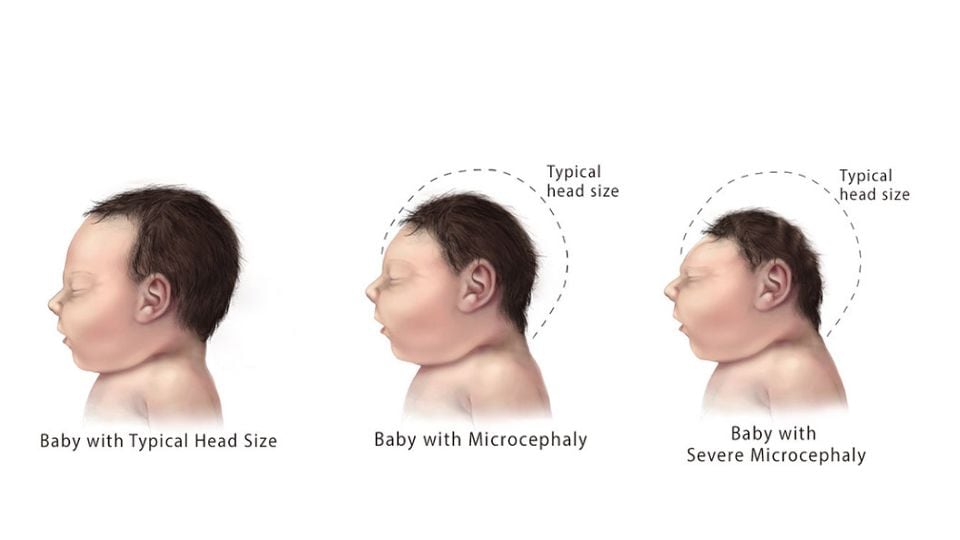Key points
- Microcephaly (my-crow-sef-ah-lee) is a birth defect where a baby’s head is smaller than expected.
- Babies with microcephaly often have smaller brains that might that did not develop properly.
- Researchers estimate that about 1 in every 1,150 babies has microcephaly in the United States
What it is
Microcephaly is a condition where a baby’s head is much smaller than expected.
During pregnancy, a baby’s head grows because the baby’s brain grows. Microcephaly can occur because a baby’s brain has not developed properly during pregnancy or stopped growing after birth. Microcephaly can occur alone or in combination with other major birth defects.

Severe microcephaly
Severe microcephaly is a serious, extreme form of this condition. It can be life-threatening.
Other problems
Babies with microcephaly can have multiple health problems, depending on the severity of the child's microcephaly. Common problems include:
Causes
The causes of microcephaly in most babies are unknown.1 Some known causes of microcephaly are:
- Infections during pregnancy, such as Zika, toxoplasmosis, or cytomegalovirus
- Malnutrition during pregnancy
- Malnutrition in the baby after birth
- Exposure to harmful substances, such as alcohol or certain drugs
- Problems with blood supply to the baby's brain during development
Diagnosis
Microcephaly can be diagnosed during pregnancy through ultrasound, or after the baby is born.
During pregnancy
Prenatal diagnosis of microcephaly can be done late in the second or early in the third trimester.
After the baby is born
To diagnose microcephaly after birth, a healthcare provider will measure the head circumference of the baby. This is a measure of the distance around the baby's head. The provider then compares this measurement to population standards using CDC charts (based on age and sex) or INTERGROWTH 21st (based on age, sex, and pregnancy duration). Microcephaly is a head circumference that is significantly smaller than the average for babies of the same age and sex.
Commonly used birth head circumference reference charts are based on measurements taken before 24 hours of age. So, it is common to measure a baby's head circumference in the first 24 hours.
Head circumference measurements may be influenced by factors related to delivery that might alter the shape of the baby's head. If the baby's head was affected by the delivery, a provider might wait longer than 24 hours. Widely accepted head circumference charts are the WHO charts for 0-2 years.
If the healthcare provider suspects microcephaly, he or she can request tests to help confirm the diagnosis and look for other problems. For example, magnetic resonance imaging can provide information on the structure of the baby's brain.
Treatment
Microcephaly is a lifelong condition. There is no known cure or standard treatment for microcephaly. Microcephaly can range from mild to severe, and treatment options can range as well. Babies with mild microcephaly often do not experience any additional problems. These babies will need regular check-ups to monitor their growth and development.
For more severe cases, babies will need ongoing care and treatment focused on managing their health problems (mentioned above). Developmental services early in life often help babies with microcephaly to improve and maximize their physical and intellectual abilities. These services, known as early intervention, can include speech, occupational, and physical therapies. Sometimes medications also are needed to treat seizures or other symptoms.
Resources
The views of this organization are its own and do not reflect the official position of CDC.
MotherToBaby: This website provides comprehensive information about exposures during pregnancy.
- Ashwal S, Michelson D, Plawner L, Dobyns WB. Practice parameter: evaluation of the child with microcephaly (an evidence-based review): report of the Quality Standards Subcommittee of the American Academy of Neurology and the Practice Committee of the Child Neurology Society. Neurology. 2009 Sep 9;73(11):887.
- Gordon-Lipkin E, Gentner MB, German R, Leppert ML. Neurodevelopmental outcomes in 22 children with microcephaly of different etiologies. Journal of Child Neurology. 2017 Aug;32(9):804-9.
- Cragan JD, Isenburg JL, Parker SE, Alverson C1, Meyer RE, Stallings EB, Kirby RS, Lupo PJ, Liu JS, Seagroves A, Ethen MK. Population-based microcephaly surveillance in the United States, 2009 to 2013: An analysis of potential sources of variation. Birth Defects Research Part A: Clinical and Molecular Teratology. 2016 Nov;106(11):972-82.
